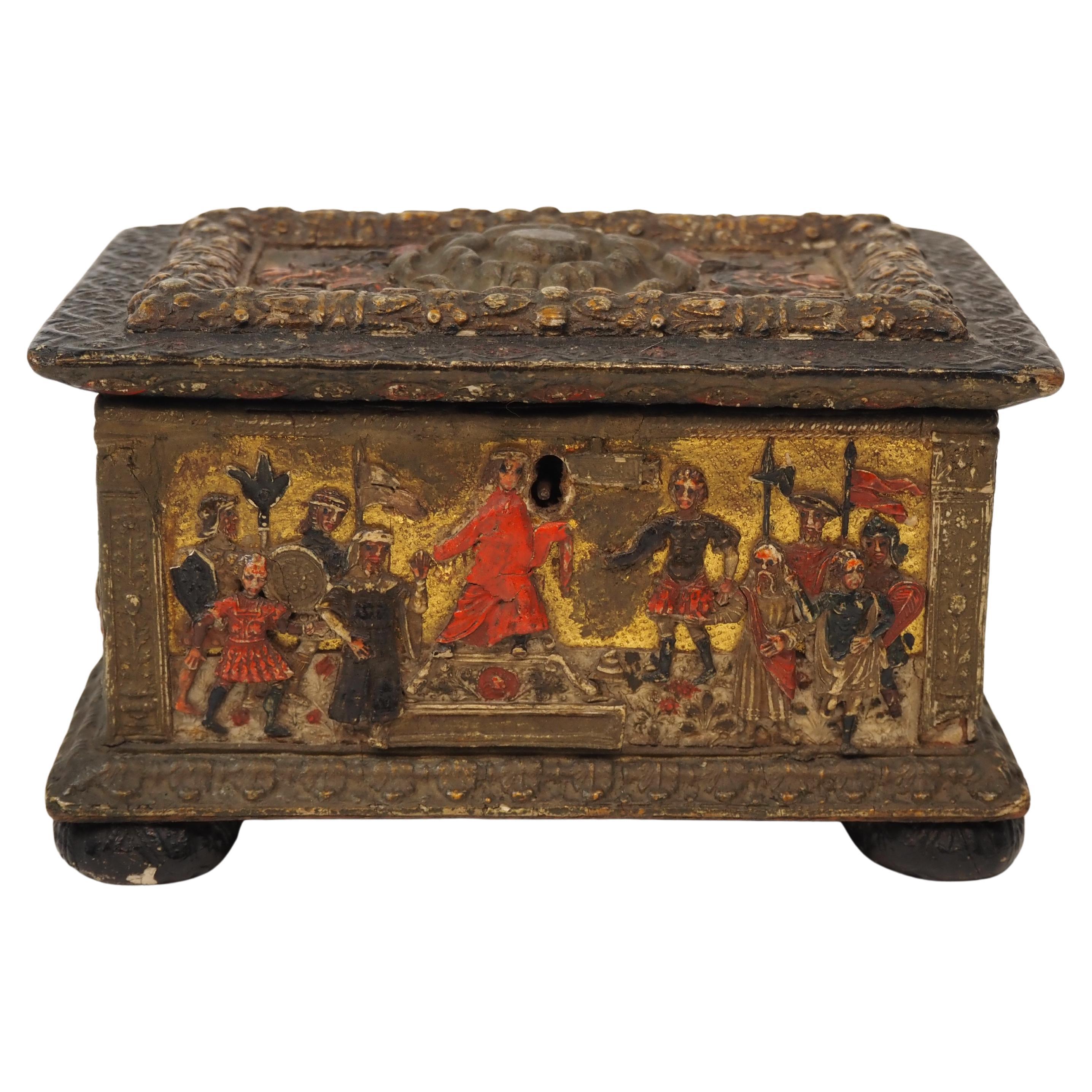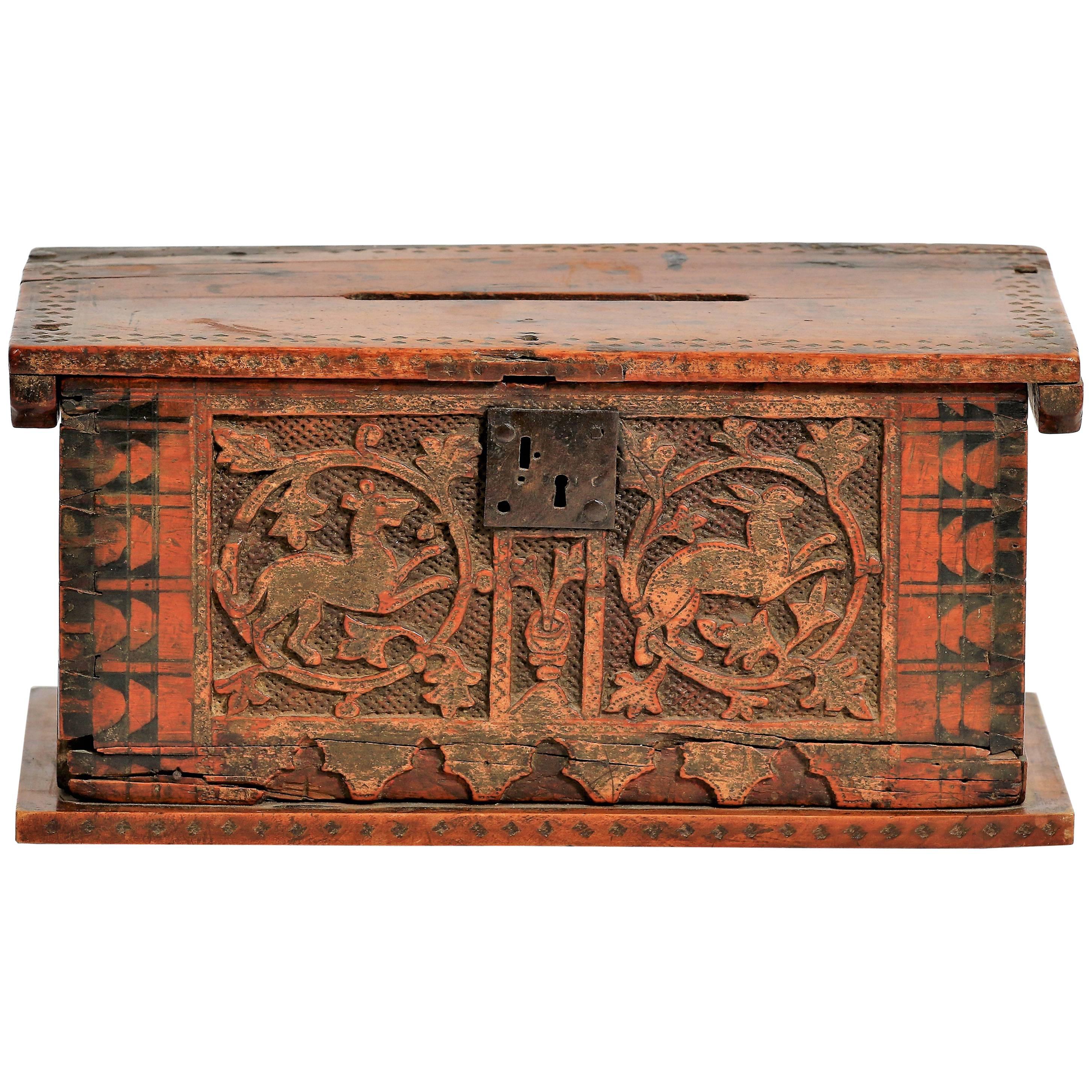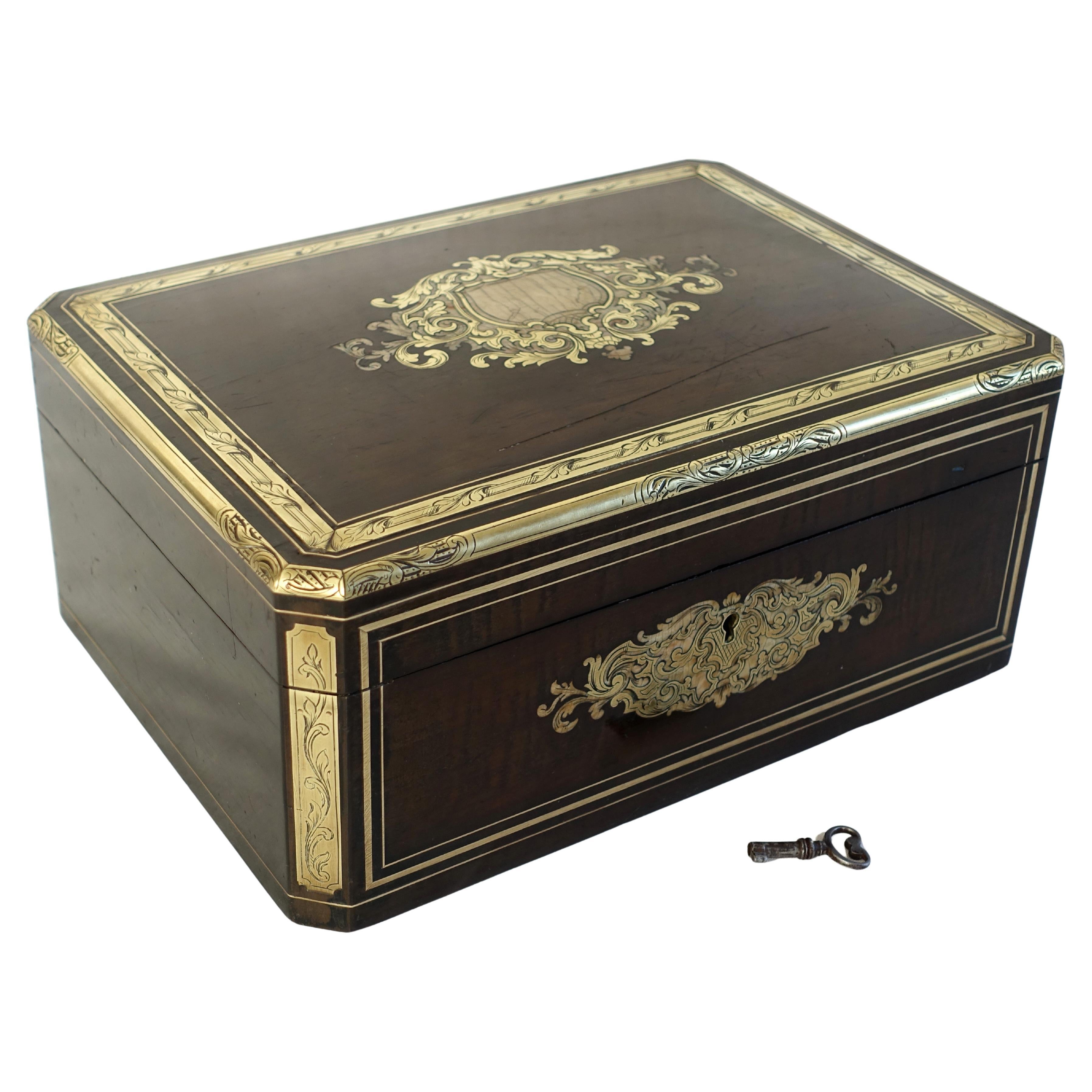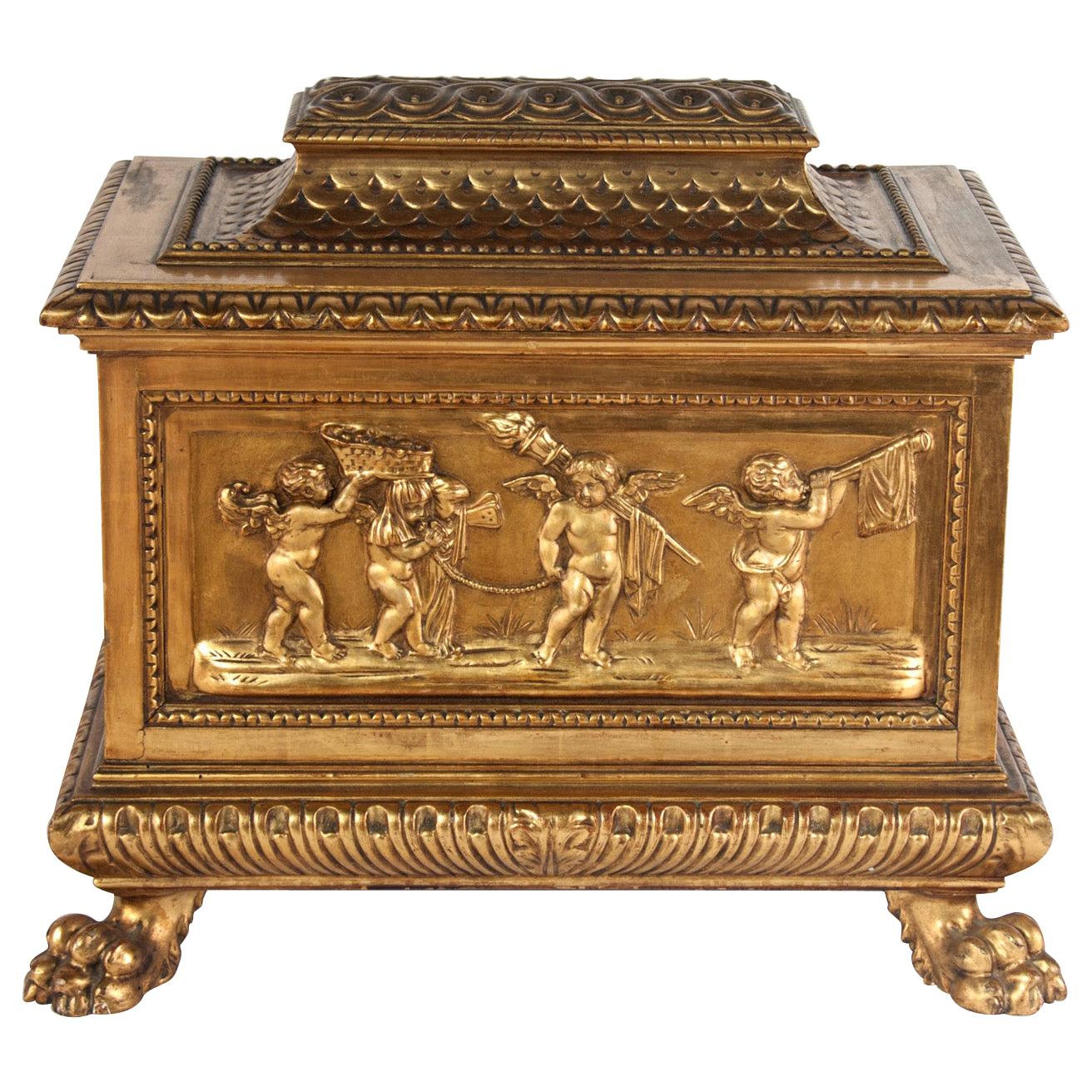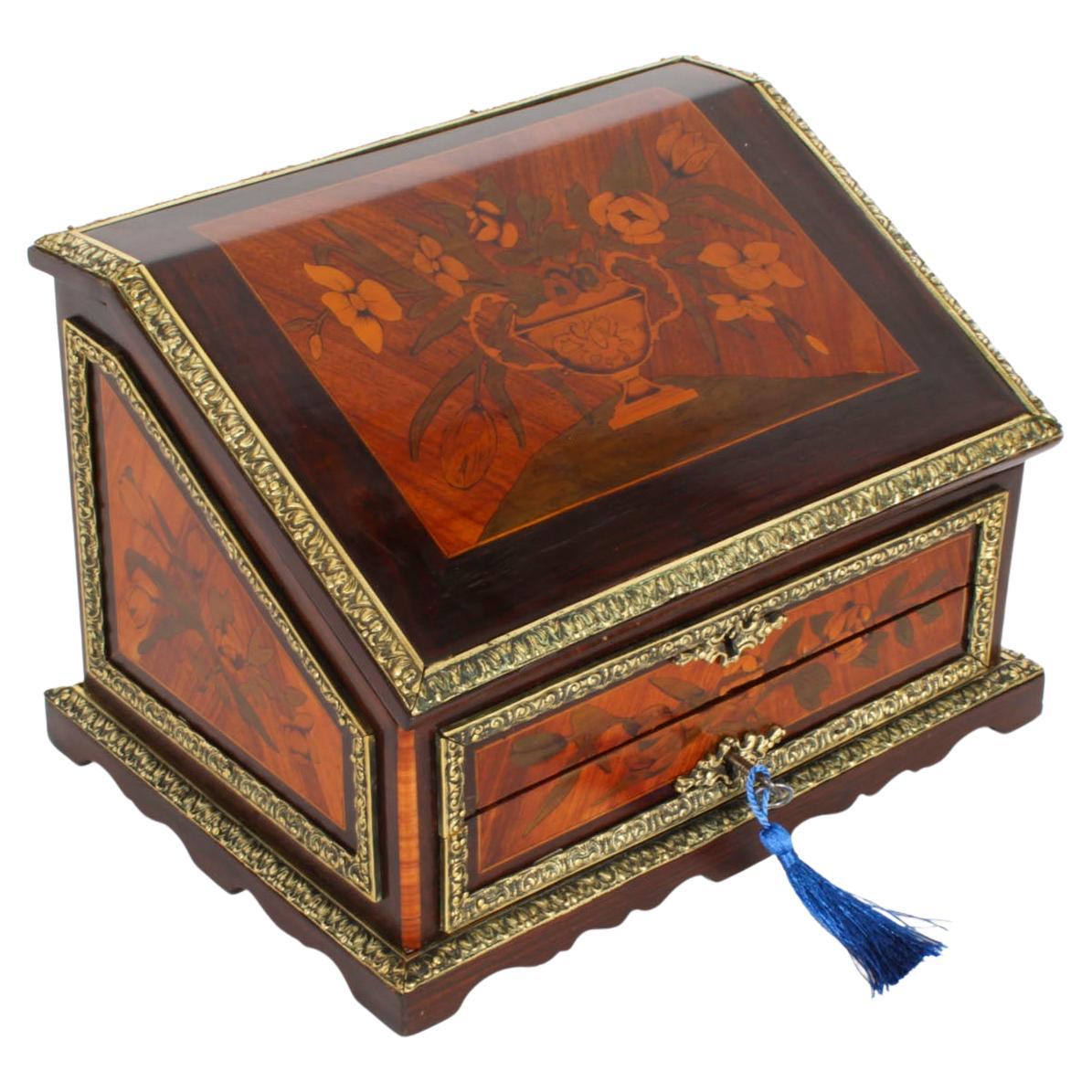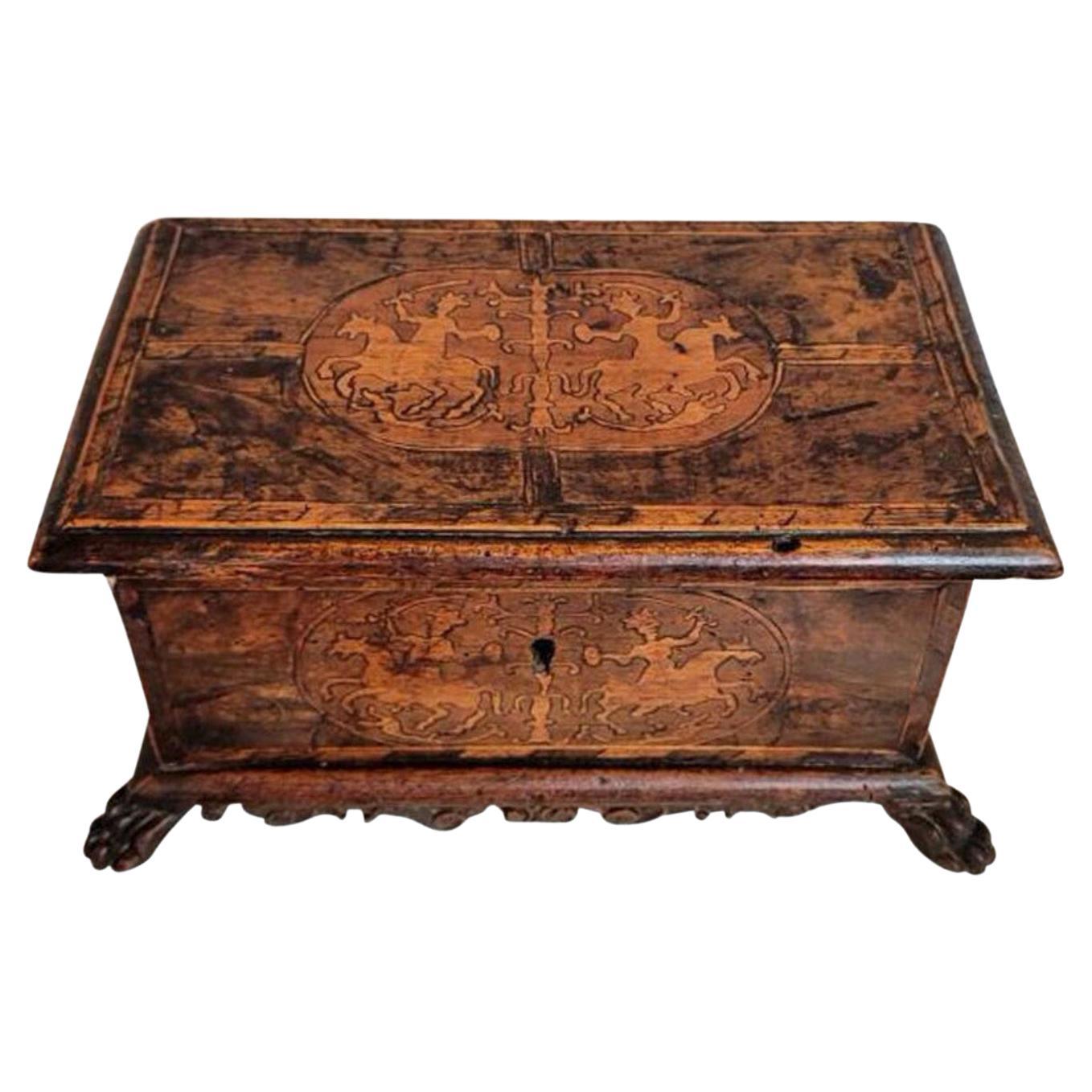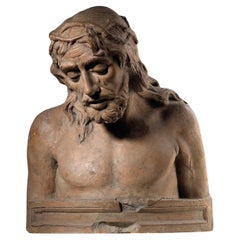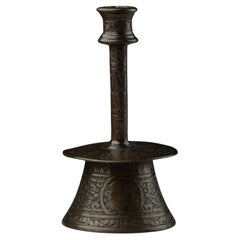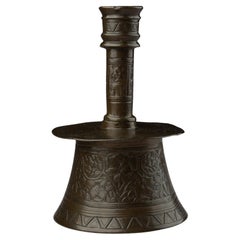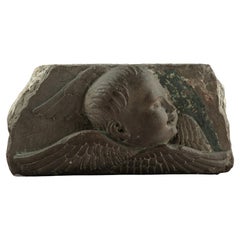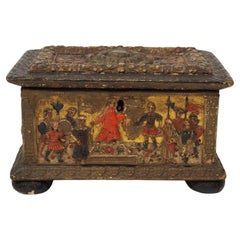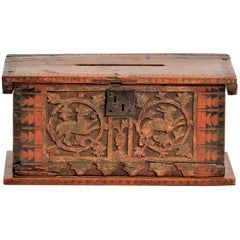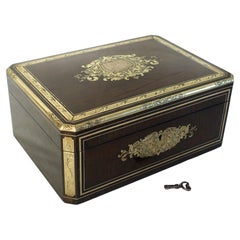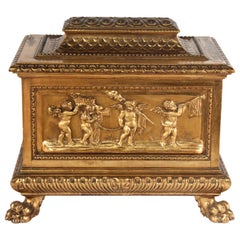Items Similar to Embriachi workshop marquetry casket - Northern Italy, 15th century
Want more images or videos?
Request additional images or videos from the seller
1 of 7
Embriachi workshop marquetry casket - Northern Italy, 15th century
About the Item
Embriachi workshop marquetry casket
Northern Italy, 15th century
Alla certosina inlays (bone, stained bone, pewter and wood)
H 28.2 x W 18 x D 14 cm
This beautiful casket of rectangular form is richly decorated with the characteristic geometric patterns of the Embriachi style.
The intricate geometric patterns are fashioned by juxtaposing lighter and darker pieces of wood, (colored) bone, horn and pewter. The lid and base are framed by a broad band of horn. When ivory became scarce in Europe due to disrupted trade routes, bone was substituted.
The attention to Symmetry and balance created an harmonious visual effect
Enhancing the overall aesthetic appeal of the casket.
The application of geometrical motifs is in Italy known as marquetry ‘alla Certosina’, named after the Certosina Church in Pavia with its famous altarpiece decorated in this way. This is ‘intarsia technique’, a term derived from the Arabic 'tarsi', which means ‘incrustation' recalling ancient mosaics made from various materials.
These geometric elements not only enhance the aesthetic appeal of the caskets but also demonstrate the versatility and skill of the artisans in creating multifaceted works of art.
‘Alla Certosina’ became famous through the Northern Italian Embriachi family who achieved a particularly high standard in working in this technique. Venice in particular was known for the production of these luxurious boxes. The caskets, hexagonal or rectangular, surmounted by a lid decorated in several registers constitute the secular, albeit equally renowned component of the workshop’s production, in addition to mirror frames and various everyday objects.
The method of fabrication of those objects was based on two concepts that underlay pre-industrial production: standardization and modularity, thanks to a distribution of skills according to the different phases of fabrication.
even the realization of the marquetry motifs (in the form of ingots from which portions of the desired size were cut) were therefore entrusted to various specialized craftsmen, as were the assembly phase.
Today better known thanks to the extensive research work recently carried out by Michele Tomasi, this workshop owes its name to its founder and owner, the Florentine Baldassare Ubriachi (or degli Embriachi), a merchant and banker established in the Tuscan capital before he settled in Venice in 1395. Together with sculptor Giovanni di Jacopo, who directed the workshop, from the last years of the fourteenth century, Baldassare oversaw a production that was truly original, and still easily recognizable today, comprising monumental altarpieces and various objects, primarily triptychs and caskets.
The precise location of the workshop is unknown, except that it originated in Florence and in ca. 1431 there was apparently a workshop in Venice, in the area of S Luca. They employed local workers specializing in 'certosina' (inlay of stained woods, bone and horn), and the workshop produced items carved in bone (usually horse or ox) with wood and bone marquetry.
The geometric decoration of Embriachi caskets reflects the artistic complexity and attention to detail that characterized their work.
this inlaid casket is a testament to the skill and artistry of the Embriachi family and serves as a stunning example of the decorative arts of the late Middle Ages.
Related Literature :
E. Berger, Prunk-Kassetten: Europäischen Meisterwerke aus acht Jahrhunderten / Ornamental Caskets: Eight Centuries of European Craftsmanship, Hanns Schell Collection, Stuttgart/Graz 1998, pp. 89-101.
Gaborit-Chopin Danielle. Michele Tomasi, Monumenti d’avorio. I dossali degli Embriachi e i loro commitenti. Monuments d’ivoire. Les devants d’autel des Embriachi et leurs commanditaires. In: Bulletin Monumental, tome 170, n°2, année 2012. pp. 185-186
F. Gualandi, L. Mor & G. Gaggioli, Capsellae. Cassette-reliquario e cofanetti della collezione Fornaro Gaggioli. Secoli XIII-XVI, Bologna 2006, pp. 24-26.
P. Lorenzelli & A. Veca, Tra/e: Teche, pissidi, cofani e forzieri dall’Alto Medioevo al Barocco, Gallereria Lorenzelli, Bergamo 1984, p. 337-344.
M. Pall, Versperrbare Kostbarkeiten, Kästchen und Kabinette aus der Welt, Hanns Schell Collection, Graz 2006, p. 38.
- Dimensions:Height: 11.11 in (28.2 cm)Width: 7.09 in (18 cm)Depth: 5.91 in (15 cm)
- Style:Renaissance (Of the Period)
- Materials and Techniques:
- Place of Origin:
- Period:
- Date of Manufacture:15th century
- Condition:Additions or alterations made to the original: the lock is missing20000. Wear consistent with age and use.
- Seller Location:Bruxelles, BE
- Reference Number:1stDibs: LU6666238331932
About the Seller
5.0
Vetted Professional Seller
Every seller passes strict standards for authenticity and reliability
1stDibs seller since 2022
15 sales on 1stDibs
Typical response time: <1 hour
- ShippingRetrieving quote...Shipping from: Bruxelles, Belgium
- Return Policy
Authenticity Guarantee
In the unlikely event there’s an issue with an item’s authenticity, contact us within 1 year for a full refund. DetailsMoney-Back Guarantee
If your item is not as described, is damaged in transit, or does not arrive, contact us within 7 days for a full refund. Details24-Hour Cancellation
You have a 24-hour grace period in which to reconsider your purchase, with no questions asked.Vetted Professional Sellers
Our world-class sellers must adhere to strict standards for service and quality, maintaining the integrity of our listings.Price-Match Guarantee
If you find that a seller listed the same item for a lower price elsewhere, we’ll match it.Trusted Global Delivery
Our best-in-class carrier network provides specialized shipping options worldwide, including custom delivery.More From This Seller
View AllEcce Homo - Florence, 15th century
Located in Bruxelles, BE
A terracotta bust "Ecce Homo"
Florence, 15th century
53 x 44 x 31 cm
Category
Antique 15th Century and Earlier Italian Renaissance Figurative Sculptures
Materials
Terracotta
Veneto- Saracenic candlestick - 15th century
Located in Bruxelles, BE
Veneto- Saracenic candlestick
Engraved bronze
15th century
12,5 x 6,2 cm
This rare candlestick exemplify exquisite craftsmanship, featuring a bell-shaped base with a flared foot ado...
Category
Antique 15th Century and Earlier Italian Renaissance Chandeliers and Pen...
Materials
Bronze
Veneto- Saracenic candlestick - 15th century
Located in Bruxelles, BE
Veneto- Saracenic candlestick
Engraved bronze
15th century
13 x 8,5 cm
This rare candlestick exemplify exquisite craftsmanship, featuring a bell-shaped base with a flared foot adorn...
Category
Antique 15th Century and Earlier Italian Renaissance Chandeliers and Pen...
Materials
Bronze
Renaissance Winged Cherub Relief
- Florence, 15th century
Located in Bruxelles, BE
Renaissance Winged Cherub Relief
Florence, Second Half of the 15th Century
Stone with traces of polychromy
Provenance: Important private collection, Northern Italy
This exceptional...
Category
Antique 15th Century and Earlier Italian Renaissance Figurative Sculptures
Materials
Stone
Pair of Gothic Columns - Italy, 14th-15th century
Located in Bruxelles, BE
Rare pair of Gothic Columns - Olivetani
Marble
Italy, 14th - 15th century
Heraldic shields on the capitals of the Order of the Olivetani
H 220 et 225 cm x W 25 x D 25 cm
H 86 2/3 & 8...
Category
Antique 15th Century and Earlier Italian Gothic Architectural Elements
Materials
Marble
$75,143 / set
Gothic Canopy, France, 15th Century
Located in Bruxelles, BE
Gothic canopy
France, 15th century
Alabaster, some traces of polychromy
33 x 23 x 20 cm
Provenance:
- Private collection Genève, Switzerland
...
Category
Antique 15th Century and Earlier French Gothic Figurative Sculptures
Materials
Alabaster
You May Also Like
Wooden casket with polychrome and gilded "pastiglia" relief decor, Italy 15th c.
Located in Gorssel, GE
A wooden box with polychrome and gilded "pastiglia" relief decor.
Italy, XV century, decorated with scenes from the life of a martyr.
Length: 15.5 x 10.4 x 9 cm.
Provenance: Dutch private collection
Overall in good condition for its age, some small defects to the decor and possibly some retouching to the polychromy, ball feet presumably of later date.
Pastiglia [paˈstiʎʎa], an Italian term meaning "pastework", is low relief decoration, normally modelled in gesso or white lead, applied to build up a surface that may then be gilded or painted, or left plain. The technique was used in a variety of ways in Italy during the Renaissance.
White lead pastiglia was a north Italian speciality, produced between about 1450 and 1550. Six workshops were identified by Patrick M. De Winter, although their location remains uncertain; the Workshop of the Love and Moral Themes, whose products seem the most numerous, was possibly at Ferrara, where the painter Cosimo Tura began his career gilding caskets. Venice is also thought to have produced them. Other workshops identified by De Winter include the "Workshop of the main Berlin casket" and "Workshop of the Cleveland Casket".
The subjects were typically classical, drawn from both mythology and Ancient Roman history (especially the early period covered by Livy), but biblical ones are also found. Compositions can often be shown to be borrowed from another medium, such as prints or bronze plaquettes...
Category
Antique 15th Century and Earlier Italian Renaissance Decorative Boxes
Materials
Gesso, Wood
Very Rare Casket Minnekästchen or Box, Germany or Italy, 15th Century
Located in Beuzevillette, FR
Wooden coffret, call minnekästchen, engraved with a dog, a hare and foliage with
polychromy remains. During the Middle Age, the hare is a symbol of fertility, joy and represents the Christ...
Category
Antique 15th Century and Earlier European Gothic Decorative Boxes
Materials
Iron
Large marquetry jewelry box or casket, 19th century
By Alphonse Giroux et Cie
Located in GRENOBLE, FR
A fine large marquetry jewelry box : amaranth veneer with brass and mother of pearl inlays ; the inside is upholstered with silk, Napoleon III Parisian production, mid 19th century c...
Category
Antique Mid-19th Century French Napoleon III Jewelry Boxes
Materials
Brass
Italian 19th C. polychromed Wooden Casket.
Located in Esbeek, NL
Italian Renaissance casket.
The casket with raised lid all carved with Cherubs on the front and back panel.
Original polychrome
Category
Antique 19th Century Italian Renaissance Decorative Boxes
Materials
Wood
Antique French Marquetry and Ormolu Stationary Casket . 19th Century
Located in London, GB
This is a wonderful antique French Gonçalo Alves marquetry and ormolu mounted casket, circa 1860 in date.
The casket of bureau form has a lift up top and is inlaid with a marquetry ...
Category
Antique 1860s Decorative Boxes
Materials
Ormolu
17th/18th Century Italian Venetian Marquetry Table Box
Located in Forney, TX
An important early antique Italian Renaissance table box, handcrafted in Northern Italy in the 17th/18th century, cassone chest form, richly inlaid, the top and front panel with fruitwood banding framing...
Category
Antique 18th Century Italian Renaissance Decorative Boxes
Materials
Wood, Fruitwood
Recently Viewed
View AllMore Ways To Browse
Northern Italian
15th Century Italian
15th Century Europe
Decorative Lighter
Horse Box
Decorative Art In The Middle Ages
Tuscan Bedroom Furniture
Italian Pewter
Italian Renaissance 15th
Italian Renaissance 15th Century
Ivory Inlay
15th Century Antiques
Arabic Wood
Ivory Inlay Furniture
Tuscan Renaissance
Monumental Italian Mirror
E Mosaic
Horn Inlay
